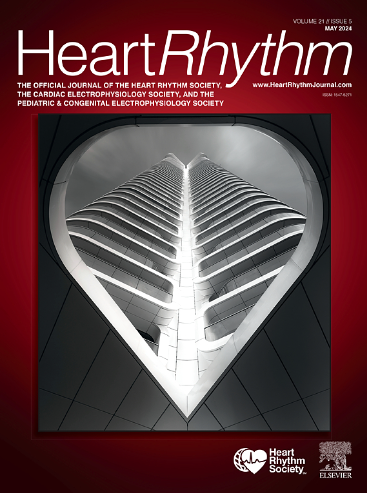Vascular access complications after catheter ablation of ventricular arrhythmias: Impact of vascular closure devices
IF 5.6
2区 医学
Q1 CARDIAC & CARDIOVASCULAR SYSTEMS
引用次数: 0
Abstract
Background
Vascular access site complications are the most frequent complications of percutaneous catheter ablation (CA) of ventricular arrhythmias (VAs). Whether arterial/venous vascular closure devices (VCDs) prevent vascular complications is unknown.
Objective
We investigated the benefit of VCDs in patients undergoing CA of VAs.
Methods
Consecutive CA of VAs were included (2018–2022). Vascular accesses were obtained with ultrasound guidance. At the discretion of the operator, arterial and/or venous VCDs were used. Cases were divided into 3 groups: no use of VCDs for any arterial/venous accesses (manual compression [MC]), use of VCDs for some but not all accesses (Partial-VCDs), and use of VCDs for all accesses (Complete-VCDs). Vascular complications were classified as minor if they did not require intervention or major if they required intervention.
Results
A total of 1016 procedures were performed in 872 patients (mean age 62 ± 13 years; mean body mass index 30 ± 6 kg/m2; 27% female) during the study period. Femoral arterial access was obtained in 887 procedures (875 single access: 7.4 ± 1.5 F size; 12 two accesses: 7.3 ± 3 and 6.9 ± 1.8 F). Femoral venous access was obtained in 1014 procedures (unilateral in 17%; bilateral in 83%; mean number of access sites per patient 2.6 ± 0.7; mean size 8.4 ± 1.3 F). Hemostasis was achieved with MC in 192 procedures (19%), with Partial-VCD in 275 (27%), and with Complete-VCD in 549 (54%). A vascular complication occurred in 52 procedures (5.1%), including a minor hematoma in 3.9% and/or a major complication in 1.7%. The rate of vascular complications was 6.8% (5.2% minor and 1.6% major) in the MC group, 7.6% (5.1% minor and 3.3% major) in the Partial-VCD group, and 3.3% (2.9% minor and 0.9% major) in the Complete-VCD group (P = .014 for comparison). In multivariable analysis, Complete-VCD remained independently associated with a lower risk of vascular complications (odds ratio 0.69; 95% confidence interval 0.48–0.96; P = .036).
Conclusion
In patients undergoing CA of VAs, Complete-VCD is associated with lower rates of vascular-related complications compared with MC or Partial-VCD.
室性心律失常导管消融术后的血管通路并发症:血管闭合装置的影响。
背景:血管通路部位并发症是室性心律失常(VAs)经皮导管消融术(CA)最常见的并发症。动脉/静脉血管封闭装置(VCD)能否预防血管并发症尚不清楚:我们研究了 VCD 对接受室性心律失常 CA 患者的益处:纳入了VAs的连续CA(2018-2022年)。在超声引导下获得血管通路。根据操作者的判断,使用动脉和/或静脉 VCD。病例分为 3 组:任何动/静脉通路均未使用 VCD(手动加压 - MC)、部分但非全部通路使用 VCD(部分-VCD)、全部通路使用 VCD(完全-VCD)。血管并发症如果不需要干预,则定义为轻微并发症;如果需要干预,则定义为严重并发症:研究期间共为 872 名患者(62±13 岁,体重指数 30±6kg/m2,27% 为女性)实施了 1,016 例手术。887例手术获得了股动脉通路(875例单条通路--7.4±1.5 Fr,12例两条通路--7.3±3 Fr和6.9±1.8 Fr)。1,014例手术获得了股静脉通路(17%为单侧,83%为双侧,平均N.2.6±0.7,8.4±1.3 Fr)。192例(19%)手术通过MC止血,275例(27%)通过部分VCD止血,549例(54%)通过完全VCD止血。52例(5.1%)手术发生了血管并发症,其中3.9%为轻微血肿,1.7%为严重并发症。MC组的血管并发症发生率为6.8%(5.2%为轻微并发症,1.6%为严重并发症),部分VCD组为7.6%(5.1%为轻微并发症,3.3%为严重并发症),完全VCD组为3.3%(2.9%为轻微并发症,0.9%为严重并发症,对比P=0.014)。在多变量分析中,完全VCD仍与较低的血管并发症风险独立相关(几率比0.69,95%置信区间0.48至0.96,P=0.036):结论:与MC或部分VCD相比,在接受VAs CA手术的患者中,完全VCD与较低的血管相关并发症发生率有关。
本文章由计算机程序翻译,如有差异,请以英文原文为准。
求助全文
约1分钟内获得全文
求助全文
来源期刊

Heart rhythm
医学-心血管系统
CiteScore
10.50
自引率
5.50%
发文量
1465
审稿时长
24 days
期刊介绍:
HeartRhythm, the official Journal of the Heart Rhythm Society and the Cardiac Electrophysiology Society, is a unique journal for fundamental discovery and clinical applicability.
HeartRhythm integrates the entire cardiac electrophysiology (EP) community from basic and clinical academic researchers, private practitioners, engineers, allied professionals, industry, and trainees, all of whom are vital and interdependent members of our EP community.
The Heart Rhythm Society is the international leader in science, education, and advocacy for cardiac arrhythmia professionals and patients, and the primary information resource on heart rhythm disorders. Its mission is to improve the care of patients by promoting research, education, and optimal health care policies and standards.
 求助内容:
求助内容: 应助结果提醒方式:
应助结果提醒方式:


